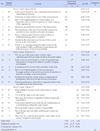1. Oh SY, Kim BS. A study of the substance of the team system operation and the effectiveness of the team system in Korean government. Korean J Public Adm. 2009; 47(1):133–158.
2. Park WW. Team system in Korea: Characteristics, effectiveness, and future directions. J Korean Bus Adm. 2007; 41:59–97.
3. Park KO. Team Managers' experience with a team system in the hospital. J Korean Acad Soc Nurs Educ. 2012; 18(3):486–498.
4. Choi SY, Nam EW. The influences of a team system's introduction to hospital organization, regarding job satisfaction and organization commitment. Korean J Hosp Manage. 2000; 5(1):232–271.
5. Kim SH. Nursing organizational culture, team effectiveness, patient's satisfaction in a team-centered hospital[master's thesis]. Seoul: Ewha Womans University;2004.
6. Kim TR, An HJ. The influence of organizational effectiveness by team system. J Korean Assoc Public Adm. 2007; 19(1):1–21.
7. Lee EJ. Change in organizational characteristics and job satisfaction by the adoption of the new organizational structure 'team framework' at a university hospital [master's thesis]. Seoul: Seoul National University;2000.
8. Lee KY, Kim DW. The research for the rationality and justification as introduction factors of team system. J Bus Adm Res. 2001; 30:1009–1035.
9. Park SH, Ju HJ, Park KK. A study on incongruence of the team-based system in the bureaucratic context. Study Korean Public Adm. 2007; 16(3):3–29.
10. Shin TH, Won IS. The research for utilization and effectiveness of team system in domestic industry. J Hum Resour Adm Res. 1995; 19:259–1035.
11. Shin CW, Lee DW. The empirical study related to the causes of failure in team system in Korean business. J Korean Bus Adm. 2002; 33:249–269.
12. Faul F, Erdfelder E, Lang AG, Buchner A. G*Power 3: A flexible statistical power analysis program for the social, behavioral, and biomedical sciences. Behav Res Methods. 2007; 05. 39(2):175–191.
13. Park CH, Lee CH. An exploratory study on the benefits team system. Korean Public Adm Q. 2006; 18(4):1003–1028.
15. Hair JF, Anderson RE, Tatham RL, Black WC. Multivariate data analysis. 5th ed. New York, NY: Prentice Hall International;1998.
16. Chang CW, Park SA. The relationships between the hospital's organizational pattern for nursing, organizational characteristics perceived by nurses and their job satisfaction. J Nurs Acad Soc. 1993; 23(3):397–416.
17. Yu BS, Yu BN. An empirical study on the strategic factors and processes for patient focus value(Focus on team-based organization). J Train Dev. 2007; 15:457–473.
19. Levi D. Group dynamics for teams. London: Sage Publication;2001.
20. Katzenbach JR, Smith DK. The wisdom of teams: Creating high-performance organization. New York, NY: Harper Business Essentials;1994.







 PDF
PDF ePub
ePub Citation
Citation Print
Print




 XML Download
XML Download